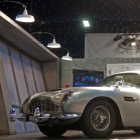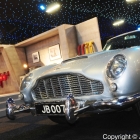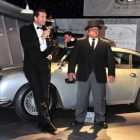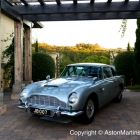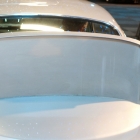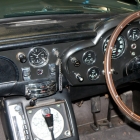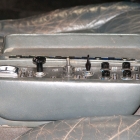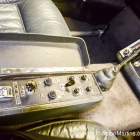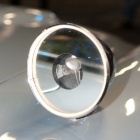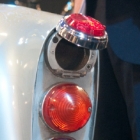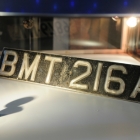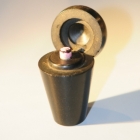The Silver Birch DB5 was crammed full of secret gadgets – many of which are total fiction, whereas some have become commonplace in modern cars. Modifications to the DB5 for the film were………..
- Front and rear extending over-rider rams
- Front firing .30 calibre Browning machine guns behind the front indicators
- Retractable tyre slashers (three eared spinners)
- Retractable rear bullet proof screen
- Radio telephone concealed in secret door compartment
- Radar scanner in racing type wing mirror, tracking screen in the cockpit
- Passenger ejector seat – roof panel jettisoned just before the seat is fired
- Oil slick ejector from nearside rear light cluster
- Triple spiked nails (calthrops) from the offside rear light cluster
- Cartridge for smoke screen released through the exhaust pipes
- Revolving number plates (BMT216A – UK, 4711-EA-62 – France and LU6789 – Switzerland)
- Armaments drawer under front driver seat
- Bullet-proof front and rear screens
Initially, the effects car, DP216/1 was the only car with the extras fitted by the film production company, DB5/1486/R was in effect just a standard road car used for much of the driving sequences. But such was the demand for the 007 DB5 to appear around the world to publicise the films, the road car, DB5/1486/R had the 007 extras fitted by the Aston Martin factory.
Both Goldfinger DB5’s also appeared in the 1965 James Bond film, Thunderball, with the addition of a Jet pack in the boot and rear firing water cannons. By 1968, the full effects car, DP216/1, still owned by AML, was returned to the Works and all the film company fitted special effects were removed prior to sale as a normal road car. Shortly after this DP216/1 was then refitted with replica effects by a Kent coachbuilder before being sold to an American collector. This car was stolen in June 1997 from a hanger in Florida and it’s whereabouts remain unknown. It may never be seen again.
The road car, DB5/1486/R, was privately owned in the USA by a collector from 1968 for more than 40 years and was seldom seen in public. Then in 2010, the owner decided to sell and the car was offered at the RM sale in London for £2.6 million (pictured here) – to another US collector.
As demand for the original movie cars to appear at events during the 1960’s was huge, two further DB5’s were converted by the factory for promotional work.
In writing this web page I have made great use of the book ‘The Most Famous Car in the World’ by Dave Worrall, the complete history of the James Bond Aston Martin DB5 which I can highly recommend.




